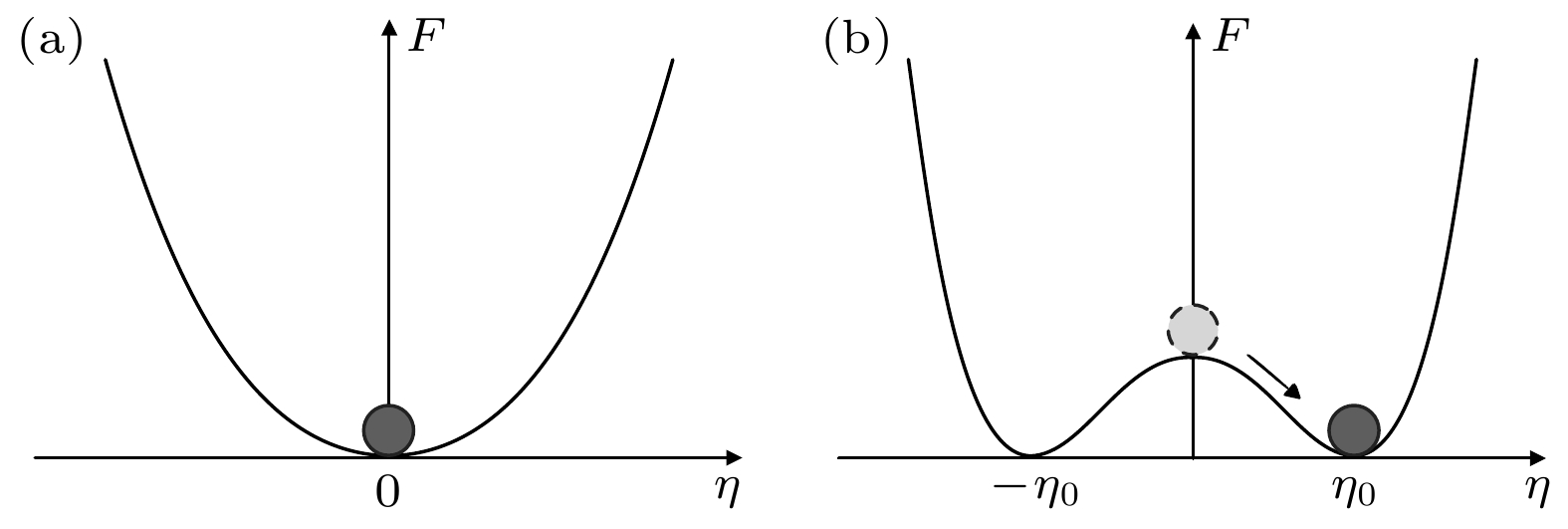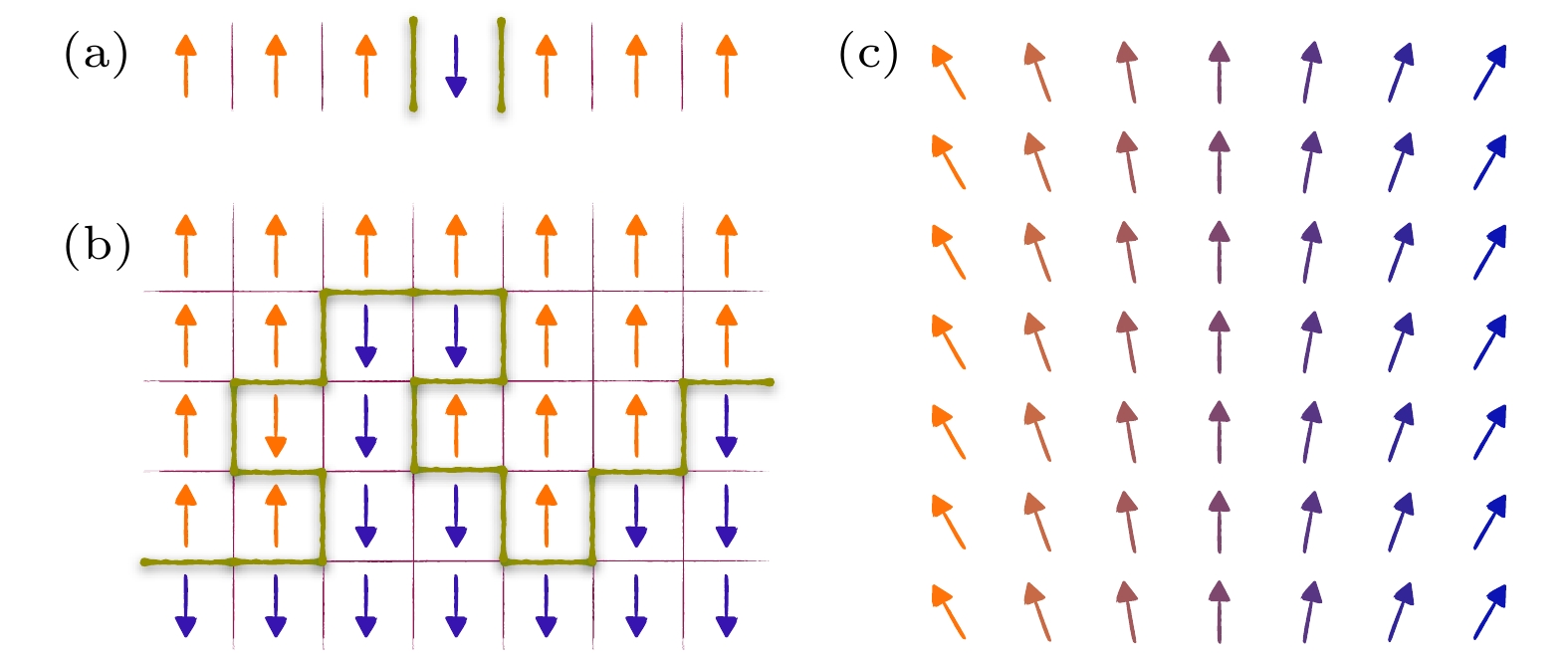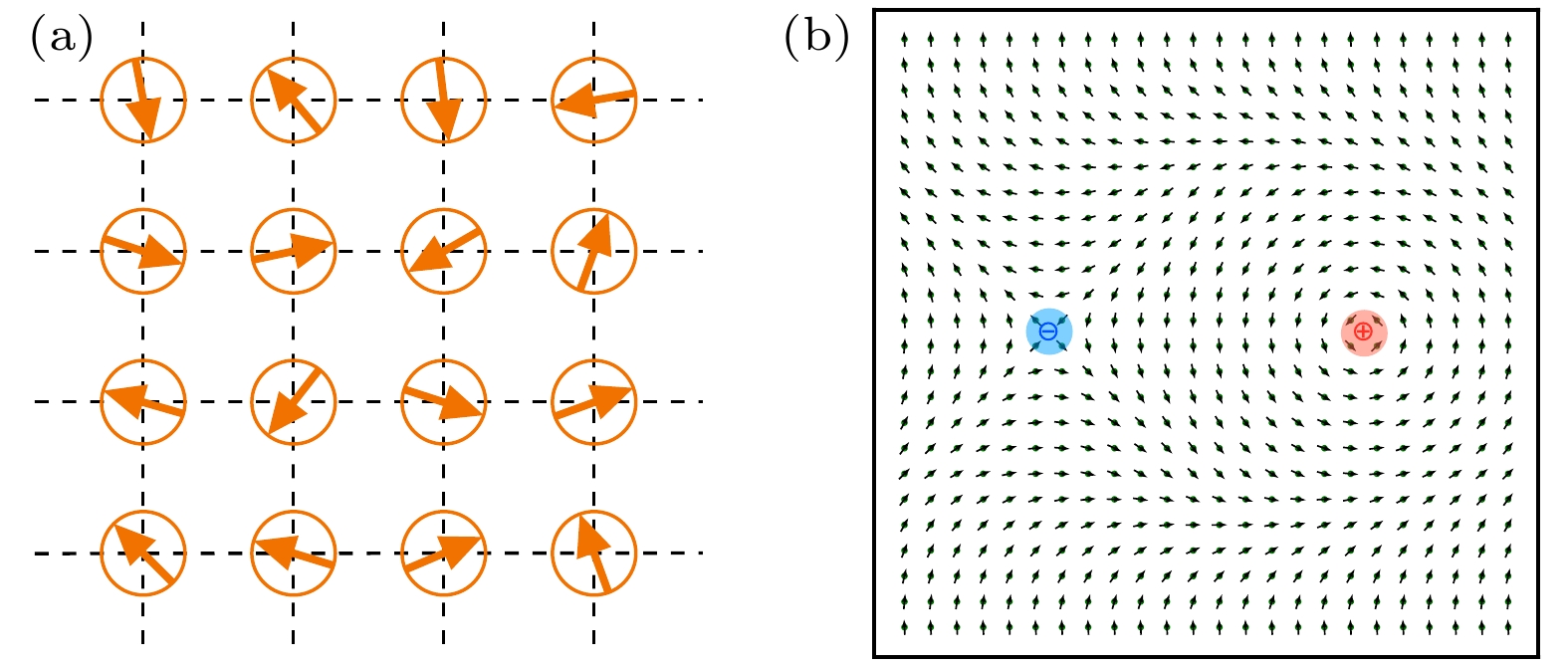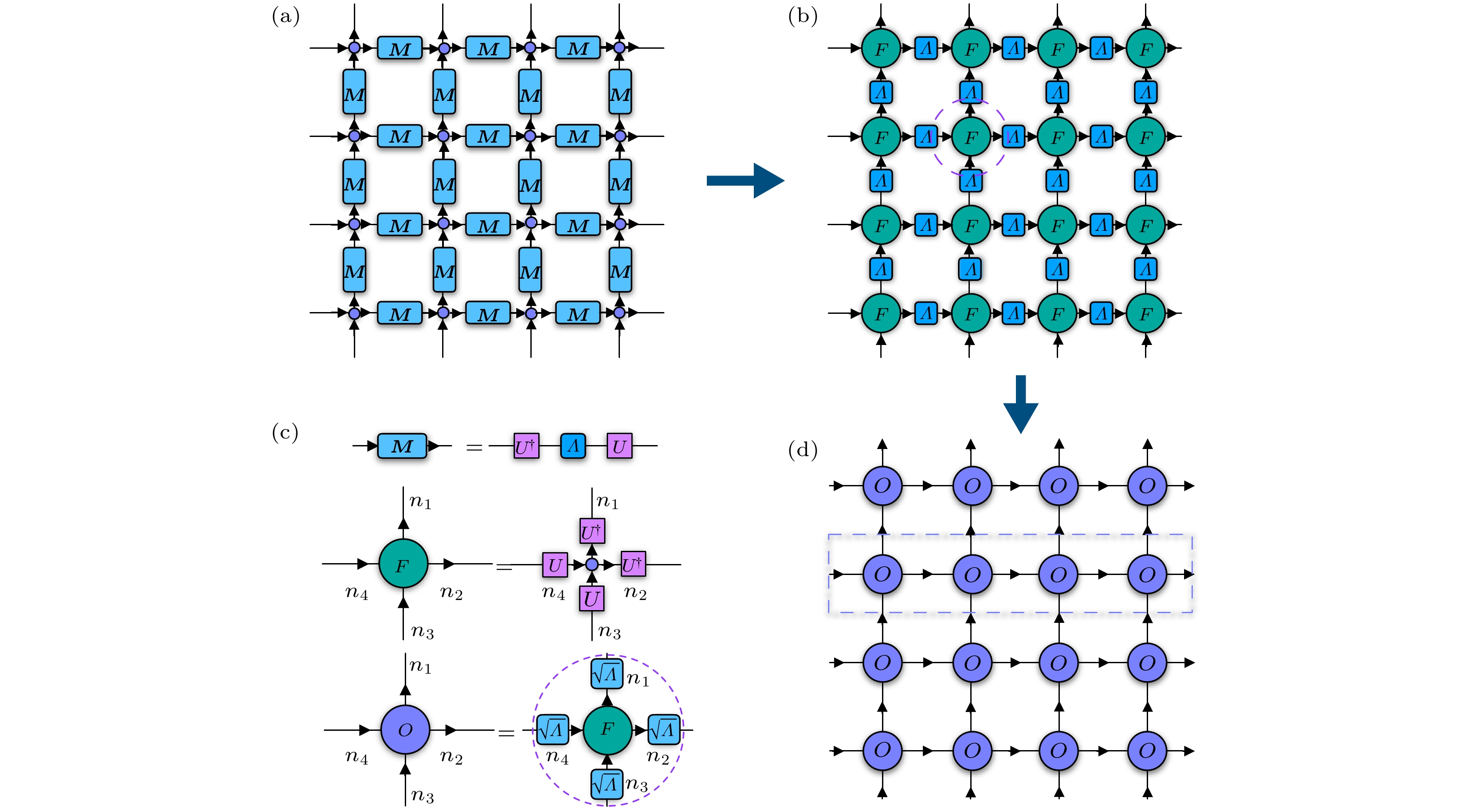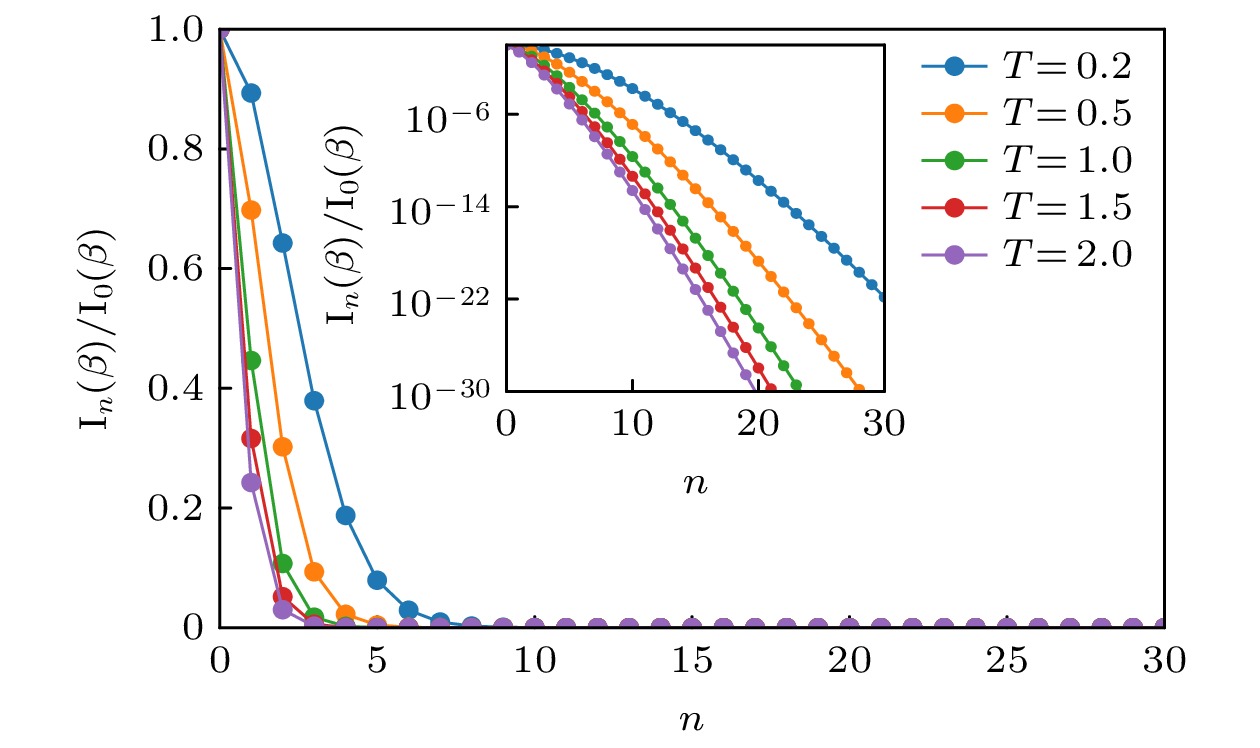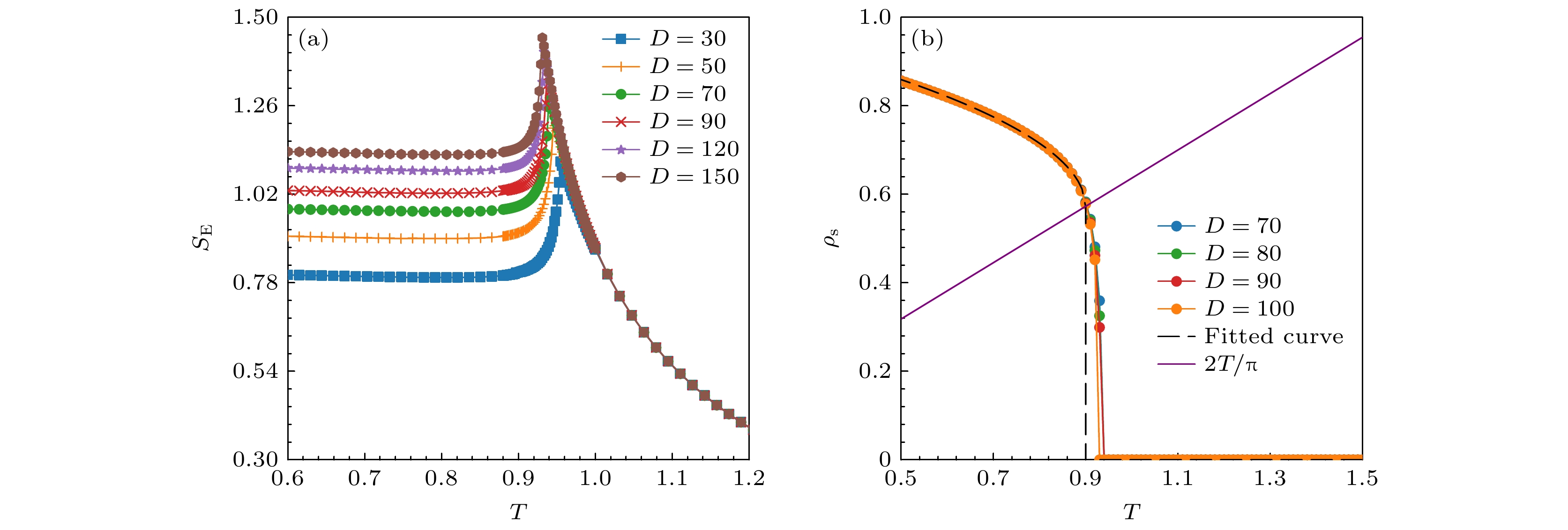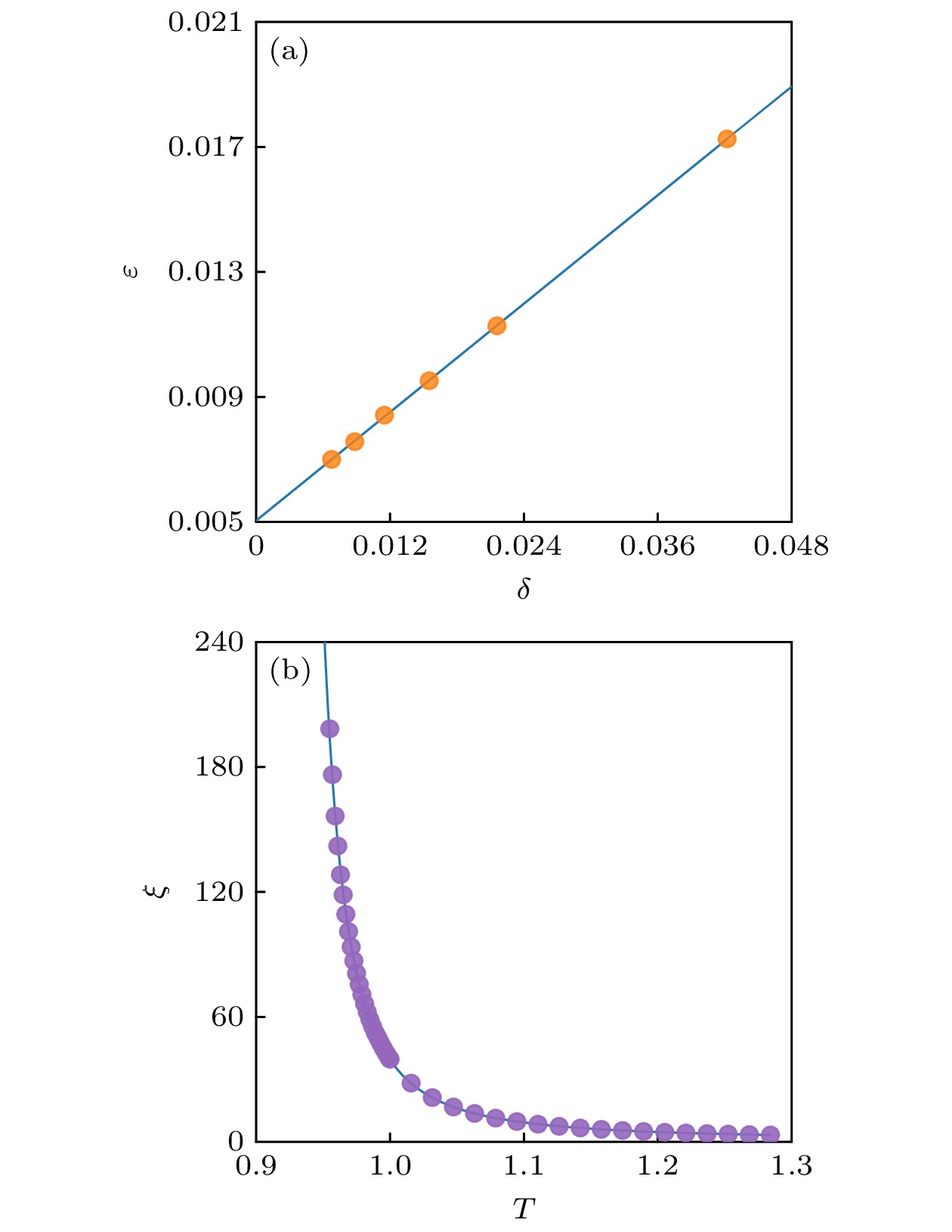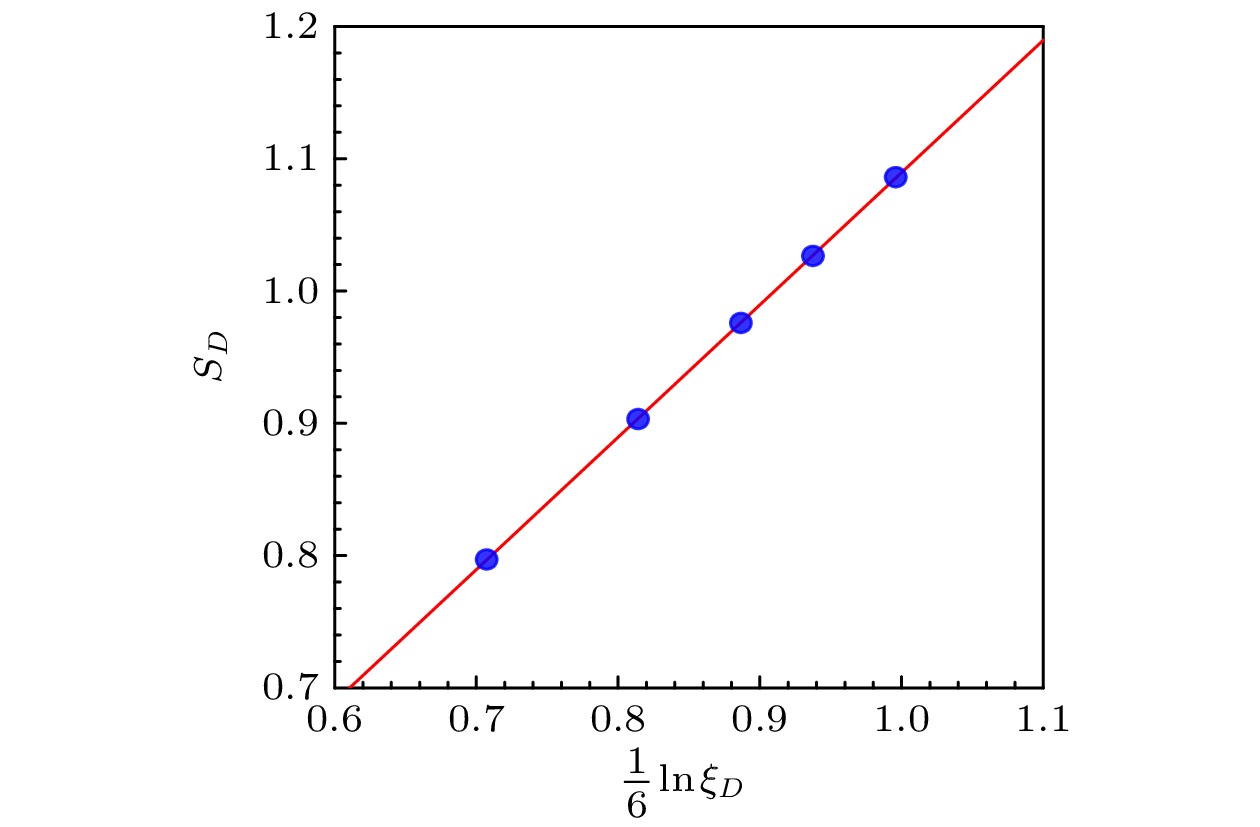-
对热力学相及相变的认知构成了我们理解整个物质世界的物理基础, 从朗道对称破缺相变范式到拓扑激发驱动的热力学相变, 相变理论的研究发展在物质科学进步之路上树立起了一座座丰碑. 一个著名的例子就是Berezinskii-Kosterlitz-Thouless相变, 它是在从低温到高温的演变过程中, U(1)旋转对称性没有自发破缺情形下, 成对涡旋的解耦合所致. 近期, 人们利用张量网络表示理论和数值计算方法, 将统计模型的转移矩阵对应为一维量子模型. 再根据量子模型纠缠熵的奇异性, 在热力学极限下可以精确确定系统的相图, 并准确计算各种物理量, 该研究方法为研究具有连续对称性的二维系统的拓扑相变注入了新活力.The fundamental concepts of phases of matter and thermal phase transitions constitute the cornerstone of our understanding of the physical universe. The historical development of the phase transition theory from Landau’s spontaneous symmetry breaking paradigm to modern topological phase transition theories represents a major milestone in the evolution of numerous scientific disciplines. From the perspective of emergent philosophy, the interplay of topological excitations leads to enriched physical phenomena. One prominent prototype is the Berezinskii-Kosterlitz-Thouless (BKT) phase transition, where unbinding of integer vortices occurs in the absence of spontaneous breaking of continuous U(1) symmetry. Using the state-of-the-art tensor network methods, we express the partition function of the two-dimensional XY-related system in terms of a product of one-dimensional transfer operators. From the singularities of the entanglement entropy of the one-dimensional transfer operator, we accurately determine the complete phase diagram of the partition function. This method provides new insights into the emergent phenomenon driven by topological excitations, and sheds new light on future studies of 2D systems with continuous symmetries.
[1] Anderson P W 1972 Science 177 393
 Google Scholar
Google Scholar
[2] 张广铭, 于渌 2010 物理 39 543
Zhang G M, Yu L 2010 Physics 39 543
[3] Landau L D 1937 Zh. Eksp. Teor. Fiz. 7 19
[4] Ginzburg V L, Landau L D 1950 Zh. Eksp. Teor. Fiz. 20 1064
[5] Wegner F 1967 Z. Phys. 206 465
 Google Scholar
Google Scholar
[6] Kosterlitz J M, Thouless D J 1973 J. Phys. C: Solid State Phys. 6 1181
[7] Kosterlitz J M 1974 J. Phys. C: Solid State Phys. 7 1046
[8] Berezinskii V 1971 Sov. Phys. JETP 32 493
[9] Wilson K G, Kogut J 1974 Phys. Rep. 12 75
 Google Scholar
Google Scholar
[10] Goldstone J 1961 Nuovo Cimento 19 154
 Google Scholar
Google Scholar
[11] Mermin N D, Wagner H 1966 Phys. Rev. Lett. 17 1133
 Google Scholar
Google Scholar
[12] Peierls R 1936 Math. Proc. Cambridge Philos. Soc. 32 477
 Google Scholar
Google Scholar
[13] Onsager L 1944 Phys. Rev. 65 117
 Google Scholar
Google Scholar
[14] Skyrme T H R, Schonland B F J 1961 Proc. R. Soc. London, Ser. A 260 127
 Google Scholar
Google Scholar
[15] Kosterlitz J M 2016 Rep. Prog. Phys. 79 026001
 Google Scholar
Google Scholar
[16] Kosterlitz J M 2018 Int. J. Mod. Phys. B 32 1830005
 Google Scholar
Google Scholar
[17] Miyashita S, Nishimori H, Kuroda A, Suzuki M 1978 Prog. Theor. Phys. 60 1669
 Google Scholar
Google Scholar
[18] Tobochnik J, Chester G V 1979 Phys. Rev. B 20 3761
 Google Scholar
Google Scholar
[19] Hasenbusch M, Pinn K 1997 J. Phys. A: Math. Gen. 30 63
 Google Scholar
Google Scholar
[20] Hasenbusch M 2005 J. Phys. A: Math. Gen. 38 5869
[21] Komura Y, Okabe Y 2012 J. Phys. Soc. Jpn. 81 113001
 Google Scholar
Google Scholar
[22] Arisue H 2009 Phys. Rev. E 79 011107
 Google Scholar
Google Scholar
[23] Hsieh Y D, Kao Y J, Sandvik A W 2013 J. Stat. Mech. : Theory Exp. 2013 P09001
[24] Verstraete F, Murg V, Cirac J 2008 Adv. Phys. 57 143
 Google Scholar
Google Scholar
[25] Orús R 2014 Ann. Phys. 349 117
 Google Scholar
Google Scholar
[26] Yu J F, Xie Z Y, Meurice Y, Liu Y, Denbleyker A, Zou H, Qin M P, Chen J, Xiang T 2014 Phys. Rev. E 89 013308
 Google Scholar
Google Scholar
[27] Vanderstraeten L, Vanhecke B, Läuchli A M, Verstraete F 2019 Phys. Rev. E 100 062136
 Google Scholar
Google Scholar
[28] Fishman M T, Vanderstraeten L, Zauner-Stauber V, Haegeman J, Verstraete F 2018 Phys. Rev. B 98 235148
 Google Scholar
Google Scholar
[29] Vanderstraeten L, Haegeman J, Verstraete F 2019 SciPost Phys. Lect. Notes 7 1
 Google Scholar
Google Scholar
[30] Haegeman J, Verstraete F 2017 Annu. Rev. Condens. Matter Phys. 8 355
 Google Scholar
Google Scholar
[31] Zauner-Stauber V, Vanderstraeten L, Fishman M T, Verstraete F, Haegeman J 2018 Phys. Rev. B 97 045145
 Google Scholar
Google Scholar
[32] Vidal G, Latorre J I, Rico E, Kitaev A 2003 Phys. Rev. Lett. 90 227902
 Google Scholar
Google Scholar
[33] Li H, Haldane F D M 2008 Phys. Rev. Lett. 101 010504
 Google Scholar
Google Scholar
[34] Pollmann F, Turner A M, Berg E, Oshikawa M 2010 Phys. Rev. B 81 064439
 Google Scholar
Google Scholar
[35] Nelson D R, Kosterlitz J M 1977 Phys. Rev. Lett. 39 1201
 Google Scholar
Google Scholar
[36] Rams M M, Czarnik P, Cincio L 2018 Phys. Rev. X 8 041033
 Google Scholar
Google Scholar
[37] Vanhecke B, Haegeman J, Van Acoleyen K, Vanderstraeten L, Verstraete F 2019 Phys. Rev. Lett. 123 250604
 Google Scholar
Google Scholar
[38] Song F F, Zhang G M 2021 Phys. Rev. B 103 024518
 Google Scholar
Google Scholar
[39] Song F F, Zhang G M 2022 Phys. Rev. Lett. 128 195301
 Google Scholar
Google Scholar
[40] Song F F, Zhang G M 2023 Phys. Rev. B 107 165129
 Google Scholar
Google Scholar
[41] Song F F, Zhang G M 2022 Phys. Rev. B 105 134516
 Google Scholar
Google Scholar
[42] Song F F, Zhang G M 2023 Phys. Rev. B 108 014424
 Google Scholar
Google Scholar
-
图 1 (a) 正方晶格上的Ising自旋模型, 所有自旋只能取上下两个方向; (b) 二维Ising自旋模型的序参量随温度的变化, Tc为二级相变临界点. 从图(b)可以看到, 实验中观测到的磁化强度方向在Tc之下只能取上下两者之一, 就像抛出一枚硬币, 尽管正反面的概率是一样的, 但是每次只是得到其中一种结果. 如果给系统施加一个外磁场h, 磁化强度方向便会完全被外场方向确定
Fig. 1. (a) Example of the classical Ising spin model on a two-dimensional (2D) square lattice, where all discrete spins can be in one of two states ($ +1 $ or $ -1 $) corresponding to the upper and lower directions; (b) temperature dependence of the order parameter (magnetization) with $ {T}_{{\rm{c}}} $ denoting the critical temperature of the second-order phase transition. From Fig. (b), we can see that the magnetization direction observed in experiments can only take one of the upper and lower directions below $ {T}_{{\rm{c}}} $. Just like tossing a coin, although the probability of heads and tails are the same, we just get one of the results each time. If an external magnetic field $ h $ is applied to the system, the direction of the magnetization is then completely determined.
图 2 (a) 朗道自由能在临界温度之上只有一个最小值点, 出现在序参量为零的地方; (b) 朗道自由能在临界温度之下出现双井构型, 对称性发生自发破缺, 序参量选择两个极小值位置中的一点
Fig. 2. (a) The Landau free energy has only one minimum point above the critical temperature, occurring where the order parameter is zero; (b) the Landau free energy shows a double-well configuration below the critical temperature, where the symmetry is spontaneously broken and the order parameter chooses one of the two minima positions.
图 3 (a) 一维Ising模型中翻转自旋会产生两个畴壁; (b) 二维Ising模型中一种可能的局部畴壁构型, 在周期性边界条件下畴壁闭合成环路; (c) 不考虑涡旋类的点状激发时, d维连续自旋模型中线度为L的畴壁切面, 相邻自旋角度缓慢变化
Fig. 3. (a) Two domain walls are created by flipping the spin in the one-dimensional (1D) classical Ising model; (b) a possible local domain wall configuration in the two-dimensional Ising model. The domain walls should close into loops under periodic boundary conditions; (c) a domain wall cross-section of size L in the $ d $-dimensional continuous spin model with slowly varying angles between neighboring spins when vortex-like excitations are not taken into consideration
图 4 不同系统中可能存在的拓扑激发 (a) 二维Ising模型中的畴壁激发; (b) 二维XY模型中涡旋的激发; (c) 二维磁性材料中Néel型斯格明子的激发可以投影到三维刺球上, 南北极分别与中心和边缘对应
Fig. 4. Possible topological excitations in different systems: (a) Excitations of domain walls in the 2D Ising model; (b) excitations of vortices in the 2D XY model; (c) excitations of Néel-type skyrmions in 2D magnetic materials can be projected onto a 3D hairy sphere, with the south and north poles corresponding to the center and edge, respectively.
图 5 (a) 正方格子上经典二维XY模型的示意, 每个XY自旋都是单位长度的平面转子; (b) 正负涡旋配对, 绕单个正负涡旋一周自旋相角改变2π. 红色表示正涡旋, 蓝色表示反涡旋
Fig. 5. (a) Schematic representation of the classical 2D XY model on a square lattice, where each XY spin is denoted as a planar rotor of unit length; (b) a rough plot of a vortex-antivortex pair embedded in a quasi-long-range ordered system, where the nearby spins were originally pointing upwards. The vortices are point-like singularities around which spin directions rotate through an angle π on a circumnavigation. The red and blue circles denote the vortex and antivortex respectively.
图 7 (a) 配分函数的玻尔兹曼因子被表示成相互作用矩阵的张量网络乘积; (b) 通过对偶变换将连续自由度积掉之后的张量网络表示; (c) 相互作用矩阵的分解, 对连续角度变量的积分以及均匀局域张量的构造; (d) 通过局域张量O表示的均匀二维张量网络, 其行转移矩阵T(β)由虚线框出
Fig. 7. (a) The Boltzmann weights of the partition function are represented as a tensor network product of the interaction matrices M; (b) the tensor network representation of the partition function after the continuous degrees of freedom are integrated out through a duality transformation; (c) the decompositions of the interaction matrix, the integration over continuous variables, and the construction of a uniform local tensor; (d) the 2D uniform tensor network representation composed of local O tensors, where the row-to-row transfer matrix $ T\left(\beta \right) $ is circled by dashed lines.
图 9 (a) VUMPS算法的核心思想是通过均匀MPS近似转移矩阵最大本征矢; (b) 通过对 MPS 的右半边求迹得到的约化密度矩阵, 其中$ {A}_{{\rm{L}}}, {A}_{{\rm{R}}} $和$ C $分别是MPS所对应的左正则、右正则和中心张量; (c) 局域可观测量的期待值被化简为收缩单个杂质张量M. 虚线框出了通道算符, $ {F}_{{\rm{L}}} $和$ {F}_{{\rm{R}}} $为其左右不动点; (d) 两点关联函数被表示为收缩一串通道算符
Fig. 9. (a) The key point of the VUMPS algorithm is to approximate the maximum eigenvector of the transfer matrix by a uniform MPS; (b) the reduced density matrix is obtained by tracing out the right half of the MPS, where $ {A}_{{\rm{L}}} $, $ {A}_{{\rm{R}}} $, and $ C $ are the left canonical, right canonical, and center tensors, respectively; (c) the calculation of the expectation value of a local observable is reduced to the contraction of a single impurity tensor $ \boldsymbol{M} $ sandwiched by the leading eigenvectors of the channel operators. The dashed line circles the channel operator, with $ {F}_{{\rm{L}}} $ and $ {F}_{{\rm{R}}} $ as its left and right fixed points; (d) the two-point correlation function is represented as a contraction of a train of channel operators.
图 11 (a) 不同MPS键维度下等效一维量子系统的纠缠熵随温度的变化, 奇异值点反映了系统中的BKT相变的发生; (b) 不同MPS键维度下自旋刚度随温度的变化. 与紫线的交叉处是理论给出的普适跃变点, 而虚线是相变附近自旋刚度行为的拟合
Fig. 11. (a) The entanglement entropy of the 1D quantum correspondence as a function of temperature under different MPS bond dimensions where the singularities indicate the occurrence of the BKT transition; (b) the spin stiffness as a function of temperature for a set of different MPS bond dimensions. The straight line $ 2 T/{\text{π}} $ is known to intersect the curve for the critical temperature and the dashed line is a fit to the behavior of the spin stiffness near the BKT transition.
图 12 (a) 关联函数在T = 0.8处随距离的衰减行为, 插图采用双对数坐标, 线性体现幂律衰减, 对应准长程有序态; (b) 关联函数在T = 1.0处随距离的衰减行为, 插图纵轴采用对数坐标, 线性体现指数衰减, 对应无序态
Fig. 12. (a) The spin–spin correlation function displays power-law behavior at $ T=0.8 $ below $ {T}_{{\rm{c}}} $ corresponding to the quasi-long-range ordered phase; (b) the spin–spin correlation function decays exponentially at $ T=1.0 $ above $ {T}_{{\rm{c}}} $ corresponding to the disordered phase. The $y$-axes of the insets are plotted in logarithmic scales.
图 13 (a) 在T = 0.955处对关联长度的外插拟合, 这里的数据点对应MPS键维D = 30, 50, 70, 90, 120, 150; (b) 外插后的相变温度之上的关联函数随温度的变化, 蓝线是利用理论公式对相变温度的拟合
Fig. 13. (a) The extrapolation procedure of the correlation length at $ T=0.955 $, where the data points correspond to the MPS bond dimensions D = 30, 50, 70, 90, 120, 150; (b) the extrapolated correlation length as a function of temperature yields a value for the critical temperature $ {T}_{{\rm{B}}{\rm{K}}{\rm{T}}}\sim 0.8930 $ when fitted to the BKT form (blue line).
-
[1] Anderson P W 1972 Science 177 393
 Google Scholar
Google Scholar
[2] 张广铭, 于渌 2010 物理 39 543
Zhang G M, Yu L 2010 Physics 39 543
[3] Landau L D 1937 Zh. Eksp. Teor. Fiz. 7 19
[4] Ginzburg V L, Landau L D 1950 Zh. Eksp. Teor. Fiz. 20 1064
[5] Wegner F 1967 Z. Phys. 206 465
 Google Scholar
Google Scholar
[6] Kosterlitz J M, Thouless D J 1973 J. Phys. C: Solid State Phys. 6 1181
[7] Kosterlitz J M 1974 J. Phys. C: Solid State Phys. 7 1046
[8] Berezinskii V 1971 Sov. Phys. JETP 32 493
[9] Wilson K G, Kogut J 1974 Phys. Rep. 12 75
 Google Scholar
Google Scholar
[10] Goldstone J 1961 Nuovo Cimento 19 154
 Google Scholar
Google Scholar
[11] Mermin N D, Wagner H 1966 Phys. Rev. Lett. 17 1133
 Google Scholar
Google Scholar
[12] Peierls R 1936 Math. Proc. Cambridge Philos. Soc. 32 477
 Google Scholar
Google Scholar
[13] Onsager L 1944 Phys. Rev. 65 117
 Google Scholar
Google Scholar
[14] Skyrme T H R, Schonland B F J 1961 Proc. R. Soc. London, Ser. A 260 127
 Google Scholar
Google Scholar
[15] Kosterlitz J M 2016 Rep. Prog. Phys. 79 026001
 Google Scholar
Google Scholar
[16] Kosterlitz J M 2018 Int. J. Mod. Phys. B 32 1830005
 Google Scholar
Google Scholar
[17] Miyashita S, Nishimori H, Kuroda A, Suzuki M 1978 Prog. Theor. Phys. 60 1669
 Google Scholar
Google Scholar
[18] Tobochnik J, Chester G V 1979 Phys. Rev. B 20 3761
 Google Scholar
Google Scholar
[19] Hasenbusch M, Pinn K 1997 J. Phys. A: Math. Gen. 30 63
 Google Scholar
Google Scholar
[20] Hasenbusch M 2005 J. Phys. A: Math. Gen. 38 5869
[21] Komura Y, Okabe Y 2012 J. Phys. Soc. Jpn. 81 113001
 Google Scholar
Google Scholar
[22] Arisue H 2009 Phys. Rev. E 79 011107
 Google Scholar
Google Scholar
[23] Hsieh Y D, Kao Y J, Sandvik A W 2013 J. Stat. Mech. : Theory Exp. 2013 P09001
[24] Verstraete F, Murg V, Cirac J 2008 Adv. Phys. 57 143
 Google Scholar
Google Scholar
[25] Orús R 2014 Ann. Phys. 349 117
 Google Scholar
Google Scholar
[26] Yu J F, Xie Z Y, Meurice Y, Liu Y, Denbleyker A, Zou H, Qin M P, Chen J, Xiang T 2014 Phys. Rev. E 89 013308
 Google Scholar
Google Scholar
[27] Vanderstraeten L, Vanhecke B, Läuchli A M, Verstraete F 2019 Phys. Rev. E 100 062136
 Google Scholar
Google Scholar
[28] Fishman M T, Vanderstraeten L, Zauner-Stauber V, Haegeman J, Verstraete F 2018 Phys. Rev. B 98 235148
 Google Scholar
Google Scholar
[29] Vanderstraeten L, Haegeman J, Verstraete F 2019 SciPost Phys. Lect. Notes 7 1
 Google Scholar
Google Scholar
[30] Haegeman J, Verstraete F 2017 Annu. Rev. Condens. Matter Phys. 8 355
 Google Scholar
Google Scholar
[31] Zauner-Stauber V, Vanderstraeten L, Fishman M T, Verstraete F, Haegeman J 2018 Phys. Rev. B 97 045145
 Google Scholar
Google Scholar
[32] Vidal G, Latorre J I, Rico E, Kitaev A 2003 Phys. Rev. Lett. 90 227902
 Google Scholar
Google Scholar
[33] Li H, Haldane F D M 2008 Phys. Rev. Lett. 101 010504
 Google Scholar
Google Scholar
[34] Pollmann F, Turner A M, Berg E, Oshikawa M 2010 Phys. Rev. B 81 064439
 Google Scholar
Google Scholar
[35] Nelson D R, Kosterlitz J M 1977 Phys. Rev. Lett. 39 1201
 Google Scholar
Google Scholar
[36] Rams M M, Czarnik P, Cincio L 2018 Phys. Rev. X 8 041033
 Google Scholar
Google Scholar
[37] Vanhecke B, Haegeman J, Van Acoleyen K, Vanderstraeten L, Verstraete F 2019 Phys. Rev. Lett. 123 250604
 Google Scholar
Google Scholar
[38] Song F F, Zhang G M 2021 Phys. Rev. B 103 024518
 Google Scholar
Google Scholar
[39] Song F F, Zhang G M 2022 Phys. Rev. Lett. 128 195301
 Google Scholar
Google Scholar
[40] Song F F, Zhang G M 2023 Phys. Rev. B 107 165129
 Google Scholar
Google Scholar
[41] Song F F, Zhang G M 2022 Phys. Rev. B 105 134516
 Google Scholar
Google Scholar
[42] Song F F, Zhang G M 2023 Phys. Rev. B 108 014424
 Google Scholar
Google Scholar
计量
- 文章访问数: 8720
- PDF下载量: 197
- 被引次数: 0













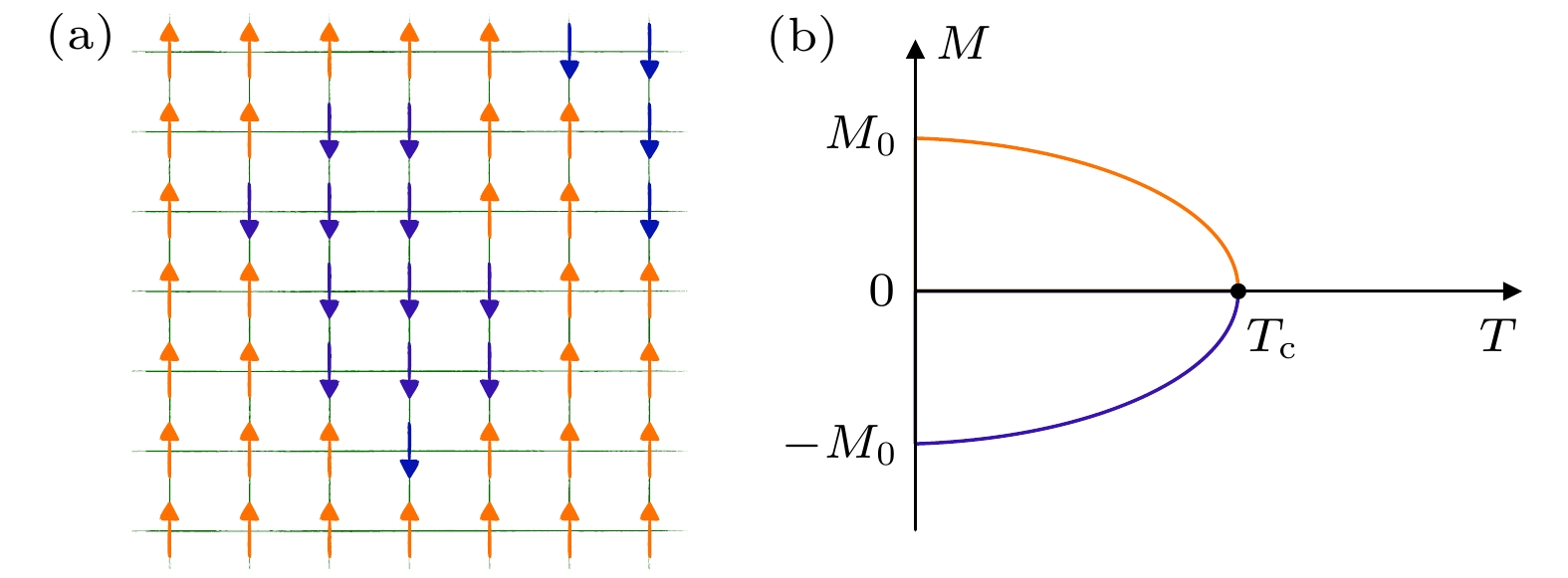
 下载:
下载:
